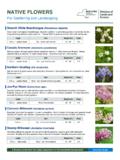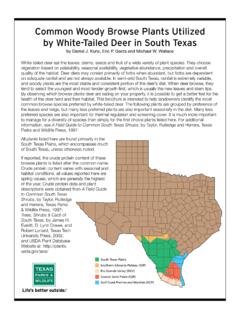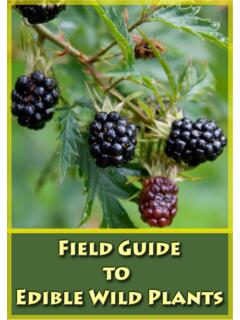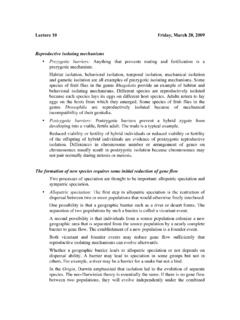Transcription of Tucson Cactus and Succulent Society Guide to Common …
1 Tucson Cactus and Succulent Society Guide to Common Cactus and Succulents of Tucson Item ID: 1 Family: Cactaceae Genus: Ferocactus Species: wislizenii Common Name: Fishhook Barrel Habitat: Various soil types from 1,000 to 6,000 feet elevation from grasslands to rocky mountainous areas. Range: Arizona, southwestern New Mexico, limited extremes of western Texas, Sonora, northwest Chihuahua and northern Sinaloa, Mexico Care: An extremely easy plant to grow in and around the Tucson area. It re-quires little attention or special care as it is perfectly at home in almost any garden setting. It is very tolerant of ex-treme heat as well as cold. Cold hardi-ness tolerance is at around 10 degrees farenheit. Propagation: Propagation of this cac-tus is by seed. Size: To 30 inches in diameter and 12 feet tall Shape: Globular flowers : The flower color can be varia-ble from yellow, to orange and red. The most typical color seen is orange.
2 Photo Courtesy of American Desert Plants Description This plant is most recognized by the large curved and hooked central spine and the large ribbed "barrel" body. The Fish-hook Barrel is the most Common barrel found growing in and around Tucson . Item ID: 2 Family: Cactaceae Genus: Echinocactus Species: grusonii Common Name: Golden Barrel Cactus Habitat: Located on rolling hills and cliffs. Range: Limited to small areas in Queretaro, Mexico. The popula-tion had become very low in num-bers over the years but is just now beginning to increase due to protective laws and the fact that this plant is now in mass cultiva-tion all over the world. Care: The Golden Barrel has slow-ly become one of the most pur-chased plants for home landscape in Tucson . It is an easy plant to grow and takes no special care. Most plants are purchased at a fairly nice size and can be easily transplanted to a garden land-scape or a decorative container.
3 It is not an extremely fast grower but can reach a very large size. Here in Tucson it is safely grown in practically any area of town and will add a nice touch of gold to your landscape. Propagation: This plant is very easily grown from seed. Size: To 24 inches wide and 40 inches tall. After many years this Cactus may offset into a multiple headed plant that is truly a prize for any gardener. can be Shape: Globular flowers : The yellow flowers are distinct because of the sharp brownish pointed petals along the outer Photo Courtesy of Vonn Watkins 1999 Description This popular barrel Cactus is noted for the beautiful golden yellow spines that thickly surround the dark green body. As with all true Echinocactus the crown or top of the stem is covered by dense white or slightly cream colored hair that is more prominent on older and larger plants. Item ID: 3 Family: Fouquieriaceae Genus: Fouquieria Species: splendens Common Name: Ocotillo (oh-koh-TEE-yo), Candlewood, Jacob's Staff, Coachwhip Habitat: Found at elevations of 3000 to 6500 feet elevation in rocky, gravelly hillsides and especially areas where limestone soils are Common .
4 Sandy plains are also a favorite for the Ocotil-lo. Range: Fouquieria splendens can be found native to southern California, the extreme southern region of Nevada, western and southern Arizona, southern New Mexico, southwestern Texas. It al-so occurs in Baja California, Sonora, Chihuahua, Coahuila, Durango, Zacate-cas and San Luis Potos , Mexico. Care: The Ocotillo is a very drought tol-erant plant and can take quite a lot of abuse. It can be dug up and transplant-ed after many days out of the soil. To best insure good health it is best to plant your Ocotillo deep enough for ade-quate support and to keep the long slender stems moist with a garden hose until it is well established. Propagation: Propagation is best from seed. Cuttings may not produce a very attractive plant. Size: Stems can grow anywhere from 9 to 30 feet tall with spines to inches long, spread to 15ft. Shape: Clustering flowers : Red flowers in the spring .
5 Leaves occur whenever there is plentiful moisture. Photo Courtesy of Mark Dimmitt 2002 Description Ocotillo is a drought-deciduous shrub. It can have anywhere from 6 to 100 wand like branches that grow from the root crown. The growth rate is very slow. Item ID: 4 Family: Agavaceae Genus: Agave Species: palmeri Common Name: Palmer's Agave, Habitat: Characteristically this Agave grows in areas inhabited by the oak woodlands from 3,000 to 6,500 ft. elevation usually in lime-stone soils. Range: A rather widely scattered species that is found throughout southeastern Arizona, southwest-ern New Mexico, Chihuahua and Sonora, Mexico Care: Agave palmeri is a rather slow growing species that is a very easy plant to cultivate in and around Tucson . It can tolerate temperatures as low as 10 degrees F. or lower but usually requires a more humus soil than typical de-sert plants. Propagation: Seed or rhizome off-sets Size: Medium sized species ft.
6 And 20-47 in. wide. Shape: Rosette flowers : Pale yellow/green to white Photo Courtesy of Chris Monrad 2003 Description This Agave is somewhat misunder-stood in that younger plants usual-ly do not offset but as the plant ages it will often send out many small rhizome offsets. Item ID: 5 Family: Cactaceae Genus: Carnegiea Species: gigantea Common Name: Saguaro Habitat: Plants are found in the Sonoran Desert of extreme south-eastern California, southern Arizo-na and northwestern Mexico. The Saguaro is at home on desert slopes, flats, and rocky areas up to about 4000 feet. Range: Arizona, California and Sonora, Mexico Care: The first word in care for the Saguaro is patience. It is easi-ly grown from seed except for the fact that from seed the plant takes many years to reach several feet in height. Most garden plants are purchased from nurseries and are already large enough for estab-lishment as a landscape plant.
7 No special requirement is needed. Extra watering can sometimes speed up the growth but this prac-tice is really up to the owner. Propagation: The Saguaro is al-ways grown from seed. Size: 35 inches wide and up to 50 feet tall. Shape: Columnar flowers : White Photo Courtesy of American Desert Plants Description The magnificent Saguaro Cac-tus, the state flower of Arizo-na, is composed of a tall, thick, fluted, columnar stem, 18 to 24 inches in diameter, often with several large branches (arms) curving up-ward in the most distinctive conformation of all South-western cacti. Item ID: 47 Family: Cactaceae Genus: Ferocactus Species: glaucescens Common Name: No Common name. Habitat: This species is found within the numerous limestone hills and boul-ders at several locations in the state of Hidalgo, Mexico. It has been noted to favor the more northern slopes and the plants are well associated with the rocky, juniper woodland community to around 5,000 feet elevation.
8 Range: Ferocactus glaucescens is only known to be native within the state of Hidalgo, Mexico and is Common in and around such areas as Meztitlan, Toli-man and Jacala. Care: Plants are easy to grow and re-quire little care once they have reached a nice flowering size. To insure robust plants in your garden they can be ferti-lized and watered around late April through May. This usually aids in main-taining a healthier plant. Be sure to limit the watering to about once a week. A well drained soil is preferred with some amounts of a good rich gar-den soil added. A good Cactus soil mix-ture is recommended for container growing. Propagation: Propagation is by seed and is very easy with this species. Size: This species can be about 20 inches in height and up to 20 inches in diameter. Multiple heads are produced as the plant ages and can form a very large mound. Shape: Globular flowers : flowers are lemon yellow and are about 1 to inches in diameter.
9 Photo Courtesy of Vonn Watkins 2003 Description The blue green appearance of this barrel with the nice light golden spines makes it very easy to identify. The spines are rather neatly distributed and the unusual looking white fruits are unmistakable. Another va-riety, "F. glaucescens var. nuda" has re-cently been introduced and is a real prize as it has little or no spines. Item ID: 6 Family: Agavaceae Genus: Agave Species: americana Common Name: Century plant, Mag-uey Habitat: Although it is a native of Mex-ico, the actual habitat has not been very well established. This Agave has been found in many types of soil and is a real survivor as the offsetting plants will continue growing long after the mother plant has died. Range: The natural location of Agave americana is unclear, but the range of this plant within Mexico is very exten-sive. It is a very desirable ornamental plant and has been widely used in the production of fiber, food and drink.
10 It has been introduced in Arizona, Califor-nia and many southern states where it is receiving much attention. It is also grown in several Mediterranean coun-tries, Africa and the far east. Care: Easily grows from separation of the numerous offsets. With added wa-ter during the heat of the summer the plant is most robust but is an easy tar-get for the Agave weevil (Scyphophorus acupunctatus). This plant can tolerate very hot dry areas and is also quite successful in coastal locations in the southeastern United States. It has been tolerant of temper-atures as low as 12 degrees farenheit if kept very dry. Propagation: Seed and by offset re-moval Size: Commonly 5 to over 10 feet in height and 10 or more feet wide. Shape: Rosette flowers : The inflorescence of this Aga-ve is a very impressive sight as the stalk can rise to over 24 feet in height. The flowers are yellow. Photo Courtesy of Vonn Watkins 2001 Description This beautiful Agave is easily recog-nized by the blue/gray leaves and its large size.









